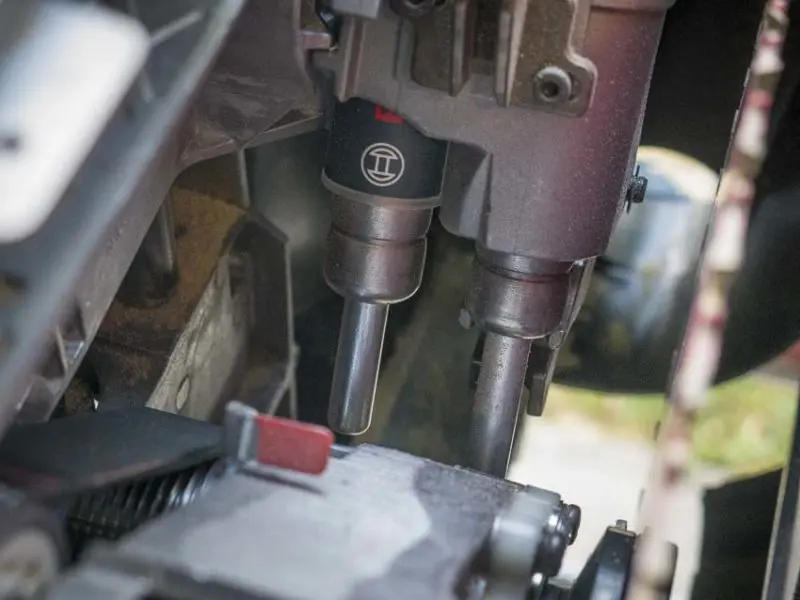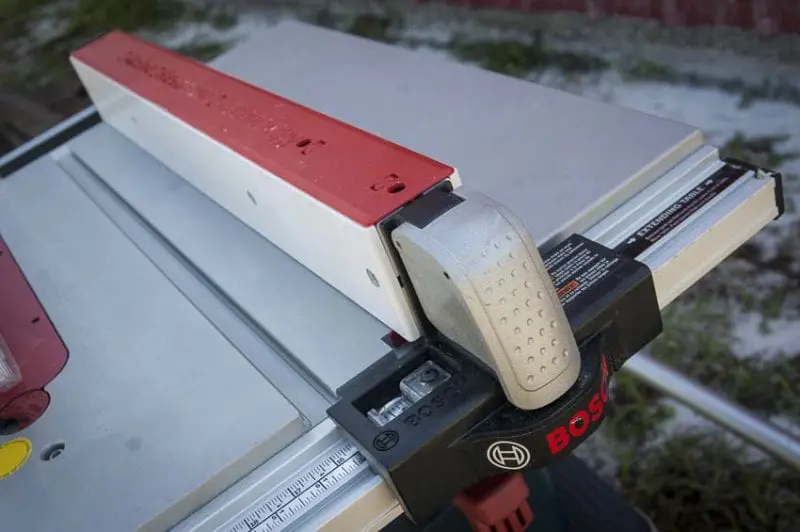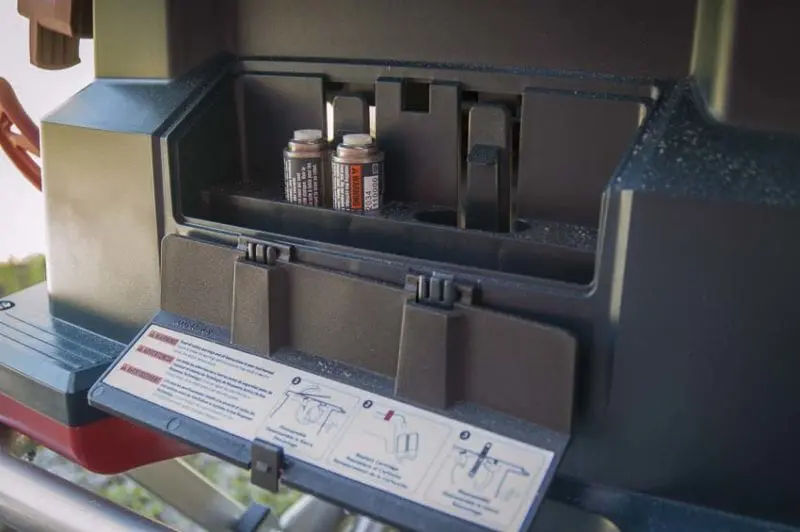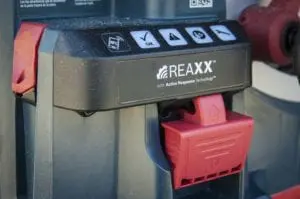Just two years ago, the only flesh-detecting saw on the market was the SawStop jobsite table saw. That all changed with the introduction of the Bosch Reaxx 1041A saw. We finally got a chance to test it out in the PTR Shop and really dive in deep. The Bosch Reaxx saw is, above all else, a really good table saw. That’s important, and I’ll attempt to outline what I like about it in the following hands-on review.
Editor’s Note: Check out our best jobsite table saw article for our top picks.
A Note About Table Saw Safety
Right up front, let’s get something out in the open: table saws have never been a safe tool to operate. It’s not that they’re necessarily going to cause an injury. There’s just not exactly a license needed to operate one, so proper training is often lacking. Many people also tend to cut corners. The first thing to go is the table saw’s blade guard. This is because it often gets in the way of particular types of cuts—and contractors tend to be in a hurry.
That leaves a very open blade with lots of potential for injury. Knowing how to use a table saw safely matters. Technology now available with tools like SawStop and the Bosch Reaxx provides flesh detection that mitigates the injuries that could occur when coming into contact with a high-speed spinning blade. The SawStop technology uses a blade brake that stops the blade and forces it below the table. It also destroys the blade in the process. The Bosch flesh-detecting saw fires a pin at airbag speeds and drops the blade below the table. It does so, however, without immediately stopping (or damaging) the blade.
Bosch Flesh Detecting Saw Features
When you add computerized control to a table saw, you end up with lots of features…and blinky lights. But the basics are just as important to understand, so we’ll start there.
Blade Height and Bevel Adjustment
It takes about 24 rotations of the height adjustment wheel to raise the blade all the way up from below the table. The first time you do that will be to cut through the blank throat plate provided with the saw. This gives you a nice tight pass-through and helps if you’re using dust collection.
I didn’t mind the circular throat plate lock, but I find that a simple magnetic or clip system is a bit quicker to use. A handy screw and locking nut allows you to quickly plane up the riving knife to your blade, which is a much better solution than the “grab it and bend it” feature in some other saws. Indeed, if you don’t read the manual, you may just end up bending the knife on the Reaxx before realizing it’s adjustable.
Raising and lowering (or even removing) the riving knife is also easy. I have smaller hands, but the access is decent. The release lever is the same as you’ll find on the Bosch GTS1031 jobsite table saw, and it works well. Just make sure you have the pins fully placed in the riving knife before tightening it.
This open-access area also helps with changing out the cartridge in the event of the tool’s protection system firing, but more on that later.
The Bosch Reaxx Fence
As with the SawStop JSS-MCA table saw, the fence on the Bosch Reaxx has non-conductive sides, so that it doesn’t trigger a blade safety event. You can easily move the fence left and right from the base, and it glides across the table smoothly. The difference is that you can also, in a pinch, grab the fence in the middle. It will still slide. Many other fences require you to grab them at the front to move them smoothly. The fence stays fairly rigid and then snaps in perfectly parallel to the blade when you push down the locking lever. We tried to intentionally lock it at a bad angle, and it always squared itself up to the table.
The extension table on the Bosch flesh-detecting table saw works by locking down the fence at 12-5/8 inches. You then use the fixed secondary pointer to set your cutting width. Lifting up the red rail lock handle frees the side extension and you just move it as needed for your cut. Then, push that handle down to lock the table extension in place. The narrow table extension provides your material support while extended.
The outfeed table on the Bosch Reaxx GTS1041A-09 model (which also comes with a Gravity-Rise wheeled table saw stand) extends the working area to around 41-1/2 inches, giving you some room to support larger sheet goods, dimensional lumber, and trim when needed.
Bosch Reaxx Accessories
Bosch went with a “tactical” push stick that sheaths into the saw like a machete for easy retrieval. It’s a great design, and more likely to get used.
On the left you have access to the blade tool and the cartridge replacement wrench. There’s also room to store an extra 10-inch blade. Nearby, Bosch also provides storage for a hybrid hex wrench and the miter guide.
The right side of the saw is where you store the fence (inverted and clamped to the underside of the table) when not in use. You also have a bracket to store the blade guard and pawls. A plastic door provides a place for the user manual and two spare cartridges.
Moving around to the back of the saw, Bosch has one of the nicest cord wraps we’ve yet seen. Positioned perfectly, the 6-foot cord stores perfectly in place. If I had a general complaint with table saw manufacturers it would be that they need longer cords. Nine or twelve feet would be far better, as 6-feet is often not long enough to reach the nearest outlet.
Bosch Reaxx Table Saw Specs
- Power: 120V, 15A, 4.0 HP
- Speed (no load): 3,650 RPM
- Blade diameter: 10 in.
- Dado size: 13/16 in. (8 in. or less)
- Arbor: 5/8 in.
- Table width (extended): 41-1/2 in.
- Rip fence capacity: 25 in. (right)
- Depth of cut (90°): 3-1/8 in.
- Depth of cut (45°): 2-1/4 in.
- Bevel range: -2° – 47°
- Table dimensions: 29-3/4 × 22-3/8 in.
- Weight (saw only): 78.0 lbs.
- Stand: 45.0 lbs. (GTS1041A-09 only)
- Rear outfeed support: 10.0 lbs. (GTS1041A-09 only)
- Includes: GTS1041A Reaxx jobsite table saw, TS3100 Gravity-Rise Stand, TS1016 rear outfeed extension support, 40 tooth blade, dual-activation cartridge, miter gauge, rip fence, Smart Guard System, push stick, dual-activation cartridge wrench, multifunction blade wrench, adjustment wrench
Using the Bosch Reaxx Table Saw
One thing about the Bosch Reaxx that leaves an impression is the smoothness of cut. Push a piece of pressure-treated 2×4 through it, and you’ll quickly fall in love with belt-drive systems. It really serves to reduce much of the vibration present in direct drive saws. Adjusting the fence is intuitive and quick, and we could get the blade guard on and off very quickly with some practice.
We had some issues with our first review sample, and you may have seen some buzz about that online. We worked with Bosch to troubleshoot the issue, and they came up with a solution. They are providing the solution to affected saws (not all have the issue). Suffice it to say that it’s a firmware upgrade plus a cable and sensor that’s easily replaced. It incorrectly reported a speed condition to the onboard processor. This gave inconsistent power results during our testing. After the fix, our sample performed as expected, and we had no further issues. The Bosch flesh-detecting saw performs just like the Bosch 4100 table saw—which is to say very well.
The Bosch Flesh Detecting Saw System in Action
We’ve seen the Bosch Reaxx and SawStop table saws tested with hots dogs and bratwurst. We’ve even seen them tested with steaks and foil insulation. But, these table saw safety systems were designed for detecting flesh. That meant we really wanted to get our hands in there…literally.
And yes, we know that’s dangerous. And no, we don’t recommend anyone else try this at home or on the jobsite.
So how do you test a tool safety system like this safely? You minimize the blade exposure, and thus the risk. We overlaid a 2×4 board and allowed the blade to pop just above the surface. That gave us the ability to test the system, but without exposing ourselves to more than a minimal amount of potential injury.
When we ran the test, the saw blade was just protruding through the top of the 2×4 board. After our “volunteer human test subject” slapped down the palm of his hand on the top of the Diablo 10-inch saw blade, the Bosch flesh-detecting saw kicked into action. The blade dropped down below the table, and the result was a scrape across his palm that could have been much worse. Putting your hand in a saw blade isn’t something we recommend, but it did allow us to see how quickly the blade reacted.
The firing mechanism is a 2-sided cartridge that can be reversed—so you get two shots. When the system detects that a finger is contacting the blade, the cylinder fires and retracts the blade down below the table in less than 3 milliseconds. It needs to be quick because the blade is spinning at 3,650 RPM. Resetting the system took us about two minutes, but with practice, your downtime will be less than that.

The next test we tried involved dragging a finger along the front of the blade. To do this, we limited exposure by placing our 2×4 perpendicular to the saw blade. We allowed only a slight amount of the blade to protrude past the bottom front edge of our lumber. Even with this precaution, however, the blade retracted only after nicking the index finger of our test subject enough to cause it to bleed. This was not, by any means, a serious injury, but it also wasn’t the “barely any mark on it” experience you get from fresh hot dog tests. Slow contact with the blade will result in very little damage. Faster, harder contacts, however, will leave a small mark or injury. Still, we can say with near certainty that the Bosch flesh-detecting saw system will save your fingers if it’s operating as intended. I won’t ever fail to be impressed by that fact alone.
A Note on False Positives
If you use really wet lumber you can accidentally cause the Bosch flesh-detecting saw to fire a cylinder. This can get expensive (and tedious), so Bosch allows you to place the saw in Bypass mode. You do this by pressing down on the Bypass switch while turning the saw on. Bypass mode is indicated with a Yellow warning light as opposed to the green light you normally see during operation. The saw only remains in bypass mode until it’s turned off—then it resets. We triggered the mechanism on the SawStop with a particularly wet piece of pressure-treated lumber, so using this feature intelligently is a requirement if you don’t want to waste time and money.
Conclusions—We Have Many!
First and foremost, the Bosch Reaxx is a really nice saw. For the $1499 price tag, it kind of has to be. There are minor dings, but not many. Dust control is finicky. The saw is designed to capture dust, and the enclosure for the blade is optimized accordingly. The trouble is that you have to manually crack open the bottom compartment to use this saw on a jobsite without a dust extractor. We also shook that bottom cover right off during one of our blade retraction safety events. It didn’t break, but it certainly surprised us.
Cutting is very smooth. We attribute this to the belt drive—a necessary component if you’re going to move the blade. This is also a very refined saw that’s intuitive and familiar to use. Bosch seems to have ironed out its sensor/power issues, so what’s left is a very adept saw that’s safer to use. We’ll be comparing the Bosch Reaxx safety system to the SawStop in a forthcoming article. That’s where we’ll compare and contrast the Bosch Reaxx saw system against the SawStop. Hopefully, when we’re finished, users can better understand the strengths and weaknesses of each.
For now, we can certainly recommend the Bosch Reaxx table saw to Pros who desire and/or require a safe solution on the jobsite. From the comments and feedback we’ve received so far, we know there’s a lot of you out there.
Update: The Bosch Reaxx is no longer sold due to Sawstop winning the lawsuit.









